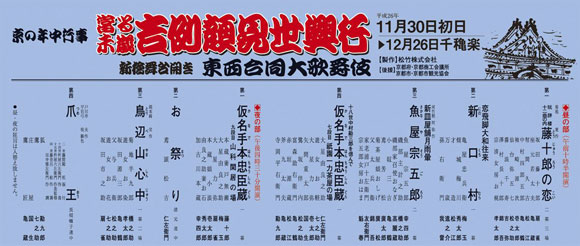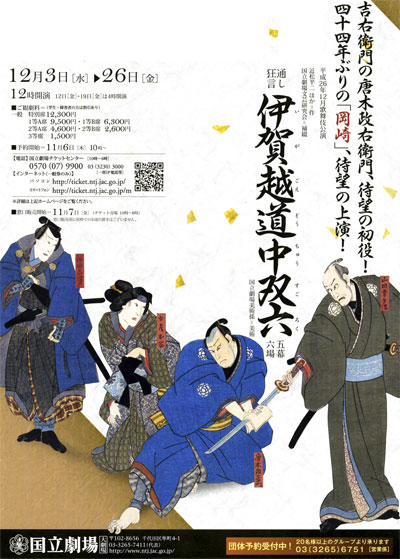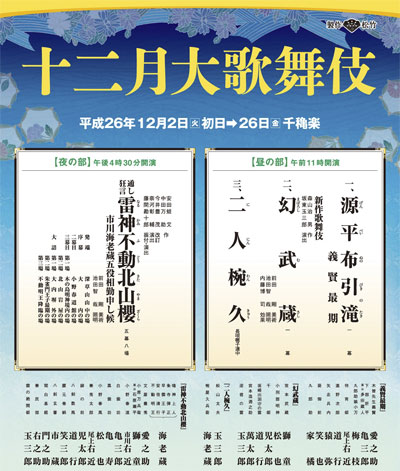| Comments |
The traditional kaomise in Ky˘to at the Minamiza:
T˘jűr˘ no Koi: this modern play by writer and publisher Kikuchi Kan shows T˘jűr˘ at the peak of his career when he has a new challenge,
to play a man who seduces a married woman, a serious thing when adultery
could be punished by death. In order to find inspiration for the role, he
finds it in real life by seducing Okaji, the owner of a restaurant. Yet when
T˘jűr˘ sees that his method of creating a role has succeeded, he leaves,
giving no thought how he has ruined Okaji's life. Starring Nakamura Senjaku as T˘jűr˘ and Kataoka Takatar˘ as Okaji.
Ninokuchi-mura: in the pleasure quarters, the most important possessions were money and reputation.
In danger of losing his lover, the courtesan Umegawa (Kataoka Hidetar˘), the money courier Chűbŕ (Nakamura Baigyoku) breaks the seals on a
package of money entrusted to him after being taunted by a rival, even though the use of such money is punishable
by death. In this scene, on their way to love suicide, the couple go through the snow covered landscape on
their way to the man's home town where they will meet their end. Featuring also Kataoka Gat˘ in the role of Chűbŕ's father Magoemon.
Sakanaya S˘gor˘: S˘gor˘ (Matsumoto K˘shir˘), a fish seller, has taken a vow
to not drink, but when he learns about his sister's unjust murder at the hands
of a daimy˘ lord, a death that
they were told was execution for her wrongdoing,
he starts to drink again. Drunk, he storms into the lord's mansion to seek an
apology. This play by Meiji playwright Kawatake Mokuami is known for its
realistic portrayal of members of the common class during the Edo period
and highlights their fierce pride and frustration at the privileges of the
dominant samurai class.
Featuring also Nakamura Hashinosuke, Nakamura Kaishun, ďtani Tomoemon, Nakamura Kikaku and Ichikawa Komaz˘.
Gion Ichiriki Jaya: "Chűshingura" is one of
the most popular plays in the theatre and shows a true event when forty-seven
masterless samurai avenged the death of their lord by killing his enemy.
The seventh act is one of the most popular and shows the leader of the vendetta
Yuranosuke as he is hiding his intention to avenge his lordĺs death by pretending
to be only interested in pleasure, but also encountering key figures on
his side and the side of the enemy. Yuranosuke (Kataoka Nizaemon)
spends his days and nights in the pleasure quarters of Ky˘to in an effort to
make their lordĺs enemy, Moron˘, believe he is not planning a vendetta.
His acting is so good that even men in his own group believe he has given his
life up to pleasure. Moron˘ is not so easily convinced, though, and has sent spies,
including a former retainer of their late lord, En'ya Hangan, to find Yuranosuke's
true intentions. Okaru (Nakamura Shichinosuke), the wife of one of the retainers is now a
courtesan at the Ichiriki Teahouse, unaware that her husband is dead.
Okaru's brother Heiemon (Nakamura Kankur˘), a servant in the Hangan household,
has also come to the teahouse and the interaction of these characters
becomes a matter of life and death and ends with Yuranosuke preparing to
lead the vendetta.
Yamashina Kankyo: this is an act of the epic play based on a
sensational incident in the early 17th century. Lord En'ya Hangan's attack on
the senior official K˘ no Moron˘ affected people even outside his own household.
When Honz˘, the senior retainer of another lord, stopped En'ya from killing Moron˘,
he thought that he was doing a good thing. But his actions earned him the
scorn of Enya's retainers and brought personal tragedy to his daughter who
was engaged to Rikiya, the son of Yuranosuke, En'ya's head retainer.
The scene shows the tragedy as it affects Honz˘'s wife and daughter and
how ultimately Honz˘ sacrifices his life to atone for his misjudgement.
Starring Matsumoto K˘shir˘ as Honz˘, Living National Treasure Sakata T˘jűr˘ as his wife
Tonase and Nakamura Kazutar˘ as his daughter Konami, with Nakamura Baigyoku as Yuranosuke,
Kataoka Hidetar˘ as his wife Oishi and Nakamura Senjaku as his son Rikiya.
Omatsuri: Kataoka Nizaemon as a gallant fireman boss at a festival telling a rueful
tale of failure in love and showing the vigorous work songs of firefighters.
Toribeyama Shinjű:
(The Love Suicides at Toribeyama)
This play by 20th century playwright Okamoto Kid˘ mixes old and new Kabuki styles.
The samurai Hankur˘ (Nakamura Hashinosuke) is in love with the courtesan Osome (Kataoka Takatar˘).
Visiting her one night in the pleasure quarters of Ky˘to, he gets into a
drunken quarrel and ends up killing a man in a fight. Knowing that execution
awaits him, the two lovers decide to die together instead.
Hankur˘ and Osome travel the road to death in new kimono that ironically
were made for them to celebrate the New Year together.
Featuring also Nakamura Senjaku, Nakamura Shichinosuke and Nakamura Kikaku.
Tsume˘:
(The Talons of the King)
This is a rare performance of a unique dance based on a childrenĺs story of a
falconer and his young falcon by Togawa Yukio (1912~2004). His stories are based on
a wealth of observation of nature and this unlikely theme for a Kabuki dance was first
staged in a commemorative performance for the Saruwaka school of classical Japanese
dance, a school closely associated with the Nakamura Kanzabur˘ family.
Featuring Nakamura Kankur˘ and Nakamura Shichinosuke.
Sources: Earphone Guide Website or Sh˘chiku Kabuki Official Website
|



